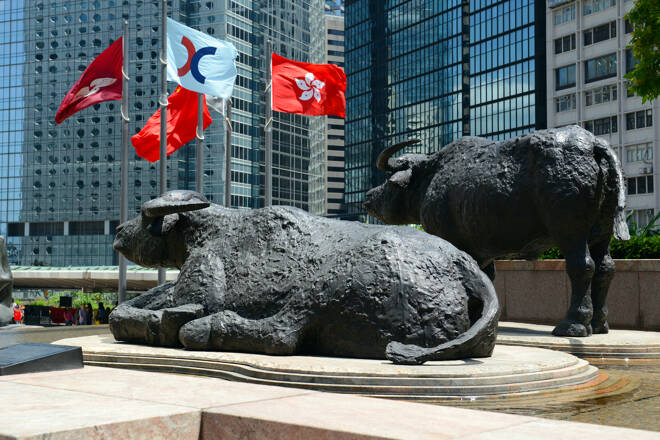Advertisement
Advertisement
Hang Seng and ASX 200 Gain as US Equity Markets Set Positive Tone
By:
Key Points:
- US equities rally, setting a positive tone for Tuesday's Asian session with strong gains across major indexes.
- China's slowing trade data and soft inflation figures highlight economic strain, raising questions about future stimulus.
- Investors await Wednesday’s US CPI report, speculating on potential Fed rate cuts amidst steady inflation expectations.
US Equity Markets Set a Positive Tone for Tuesday
On Monday, September 9, the US equity markets had a bullish session. The Nasdaq Composite Index gained 1.16%, while the Dow and the S&P 500 advanced by 1.20% and 1.16%, respectively. The bullish Monday session set the tone for the Tuesday Asian session.
Steady Consumer Inflation Expectations Amid Dip Buying
Consumer inflation expectations held steady at 3% in August. However, the numbers had a limited impact on market risk sentiment as investors bought the dip. Wednesday’s US CPI Report will likely have a greater impact on the markets amidst speculation about the September Fed rate cut.
Fed’s Rate Path Under Scrutiny
Arch Capital Global Chief Economist Parker Ross shared his views on recent US economic indicators and the Fed rate path, stating,
“A generally soft string of data last week culminated with a weak but not ugly jobs report, which likely isn’t enough to push the Fed to start its rate cutting cycle with a 50bps cut next week. Although I obviously think a 50bps cut is warranted, given how far behind the curve the Fed is, I don’t think the data in-hand has spooked the Fed enough yet to prompt a more aggressive start to the easing cycle.”
Looking at this week’s economic data, Ross does not see the stats to support a larger rate cut, unless there is a spike in the US jobless claims.
Aussie Sentiment Wanes
On Tuesday, September 10, business and consumer sentiment figures signaled a possible deterioration in the macroeconomic environment.
The NAB Business Confidence Index fell from +1 in July to -4 in August. Downward trends in business confidence could adversely affect the Aussie labor market, consumer confidence, and private consumption.
Meanwhile, the Westpac Consumer Confidence Index declined by 0.5% in September after rising by 2.8% in August. Concerns about the Aussie labor market and a possible hard landing affected sentiment.
A continued downward trend in consumer confidence may affect private consumption and the Aussie economy. Private consumption contributes over 50% to the Australian economy. Significantly, weaker private consumption may dampen demand-driven inflation, possibly supporting a Q4 2024 RBA rate cut. A more dovish RBA rate path could boost demand for ASX 200-listed stocks.
Weak China Trade Data Signals Economic Strain
Trade data from China painted a gloomy picture of the demand environment. Exports increased by 4.6% year-on-year in August, down from 7.0% in July. Additionally, imports rose by 2.5% year-on-year in August, down from 7.2% in July. The weaker-than-expected numbers could pressure Beijing to introduce more stimulus to bolster the Chinese economy.
Expert Views on China’s Economy
Natixis Asia Pacific Economist Alicia Garcia-Herrero commented on China’s recent inflation figures and economy, stating,
“China’s headline CPI slightly increased to 0.6%, but core CPI decreased to 0.3%, falling short of market expectations and confirming China’s poor demand. Financial conditions also point to a lack of demand with total social financing growing at historically low level (below 9%) since early this year. Where is the stimulus?”
Hang Seng Index and Mainland China Indexes Diverge
The Hang Seng Index gained 0.35% on Tuesday morning. Tech stocks contributed to the gains, tracking the Nasdaq Composite Index.
The Hang Seng Tech Index (HSTECH) was up 0.35%. Notable movers included Alibaba (9988), which surged by 4.34%, while Baidu (9888) was up by 1.58%. Tencent (0700) bucked the trend, falling by 0.14%.
On the other hand, concerns about the Chinese economy impacted the real estate sector. The Hang Seng Mainland Properties Index slid by 3.00%, capping overall gains for the Hang Seng Index.
Meanwhile, the Mainland China markets opened with losses. The CSI 300 and the Shanghai Composite declined by 0.38% and 0.32%, respectively.
Nikkei Index Climbs on a Weaker Yen and Bullish US Session
The Nikkei Index advanced by 0.08% on Tuesday morning, with a stronger USD/JPY driving buyer demand for Nikkei Index-listed export stocks.
Tokyo Electron Ltd. (8035) rallied 2.88%, with Sony Corp. (6758) advancing by 1.88%. Softbank Group Corp. (9984) gained 0.95%. However, investors remained cautious ahead of the US CPI Report.
ASX 200 Tracks US Market Gains
The ASX 200 Index advanced by 0.61% on Monday morning. Gains were broad-based, with bank, mining, oil, and gold-related stocks contributing.
Commercial Bank of Australia (CBA) rallied 1.45%, while Northern Star Resources Ltd. (NST) gained 0.61%. Mining giant Rio Tinto Ltd. (RIO) advanced by 1.15%.
Investors should remain alert, with central bank commentary pivotal as the US CPI Report looms. Closely monitor the news wires, real-time data, and expert commentary to manage trading strategies accordingly. Stay informed with our latest news and analysis to manage positions across the Asian equity markets.
About the Author
Bob Masonauthor
With over 28 years of experience in the financial industry, Bob has worked with various global rating agencies and multinational banks. Currently he is covering currencies, commodities, alternative asset classes and global equities, focusing mostly on European and Asian markets.
Latest news and analysis
Advertisement
